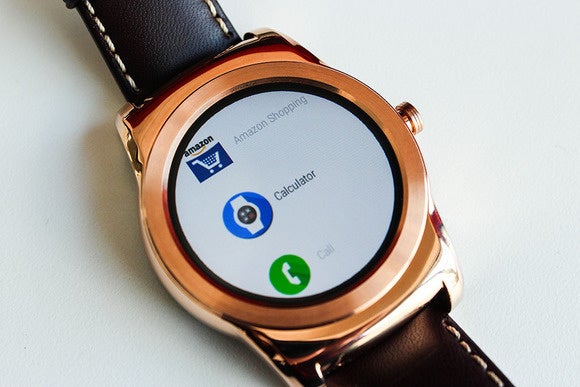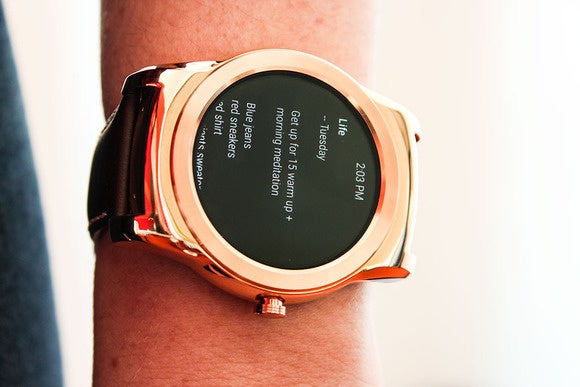I’m going to be honest with you here: I haven’t been wearing an Android ar watch. My Moto 360 has been sitting on my nightst in its charging cradle, collecting dust. Once in a while, I’ll set it to wake me up the next morning if I have a particularly important meeting to be on time for, but other than that it doesn’t get much use.
You might see it as waste of money, quite frankly that’s how I’ve felt about Android ar—until now. The initial software was too inconsistent. I’d have a different experience every time I put on the watch.
But I feel differently since toying with Android ar 5.1—especially while using it with the stylish gold tch Urbane. It brings with it new functionality that’s actually useful, beyond just pushing notifications willy-nilly from my phone to my wrist. It’s renewed my faith in ’s wearable operating system makes it seem like everything before has been a big public beta test.
Better touch controls menus

You don’t need a third-party app to launch an app on Android ar anymore.
refined Android ar’s interface a bit. Swiping down reveals a redesigned quick menu, while tapping directly on the interface directs you right to the application launcher. It’s awesome! But I feel bad for the developers behind applications like ar Mini uncher because it essentially negates the need for such an app. Then again, if you want launcher accessibility with both a left- right-swipe, there’s no reason not to have the app installed.

It’s nice to have the people I contact the most readily available from my wrist.
Another swipe to the left will bring up your most used Contacts. th each of them, you can send a text, an email, or start a phone call. For something more specific, you’ll have to dig into your bag for your phone.
Android ar now also supports gestures that let you flick your wrist up or down in almost any app to move between pages. You can easily enable them from the Settings menu they actually work remarkably well. They’re especially useful when you’re in the TSA line you’ve only got one h to flip through cards.
Ambient more for every app
Developers can now take advantage of Android ar’s existing battery-saving ambient mode to add more utility to an app you might use for an extended period of time. Maps Keep are the first apps to utilize this new feature you don’t have to toggle anything on—it just simply works.

Your to-do list for the day can stay available without eating up too much battery life.
I used Keep to glance at a list while at the grocery store the other day to pick up some ingredients for dinner, but anytime I’d flick my wrist toward me, it’d light up. That’s the how the gesture is supposed to work, but it bothered me a bit: isn’t the whole point of always-on mode to keep an app on the display without killing battery life? I felt like I was tricking it any time I’d turn the watch toward me.
I like that there’s a dim mode for apps—it actually downplays some of the gimmick of having Android on your wrist. I just wish there was a way to adjust the sensitivity of the gestures so that the screen isn’t brightening up every time I look at the watch. I don’t want a person adjacent to me to see what my watch is displaying, either.
Drawing emoji
live in a day age where some people only communicate through emoji. I don’t have the patience for that sort of thing, though I do like to send little virtual kisses to my fiancé throughout the day being able to do so from my wrist is really convenient.

Drawing emoji is weird fun at the same time.

The best part is seeing what options Android ar offers you. Sometimes they’re so ridiculous, you can’t help but laugh.
Drawing emoji on a 1.3-inch screen is admittedly weird, but not because didn’t make it functional; it’s just that the size of your fingers will become obvious to you the minute you attempt to draw out your little figures. Some emoji are easier to draw than others. The puckered-up kissy face is one of the easiest, for instance, followed by a heart, or a check mark, or any smiley face of any sort, really. It’s when you start to draw objects that it gets a bit complicated.
I tried to send my cousin a smartphone emoji as a hint that we should plan a phone date. Getting Android ar to recognize that what I was drawing was a phone not a building was a challenge. Animals are tough, too, if you’re drawing something more involved than than a cat or a snake. For those particular moments you need an emoji that’s just too involved to draw on a tiny screen, you may as well bust out your smartphone do it the old-fashioned way.
ar through -Fi

Android ar’s -Fi capabilities were useful, though they didn’t always work as intended.
Android ar 5.1 now includes -Fi capabilities for devices that support it. The watch will hook up with -Fi networks your phone has also connected to. This ensures that you keep receiving notifications even when the two devices are out of range of one another.
I had high hopes for Android ar’s -Fi capabilities, but there are still some kinks to work out. The Urbane’s -Fi abilities, for instance, ensured that I was constantly getting notifications for Instagram Hangouts even while I was in another part of the office building, dozens of feet away from my phone. But when it came to apps like Source, an RSS reader, or even Amazon Shopping, it wouldn’t load unless I was directly next to my phone. I’m assuming those apps just don’t have the functionality yet.
A lock screen to block the snoops in your life
has said that the biggest threat to Android security is actually the people in your life, so it makes sense that it added a lock screen functionality to Android ar to help protect your watch when you’re not around.

Set up a lock screen pattern to lock up your Android ar device.
You can set up a lock screen pattern to unlock your wearable device just as you would on your phone. The ck Screen feature automatically engages once you take the watch off your wrist. It’s an even better utility to have on while your watch is charging out of plain sight.
A little less beta

Android ar feels a little more complete these days.
The latest Android ar update makes the software a little less beta a bit more sellable on paper. th all these new, stylish watches hitting the market, there’s finally a reason for even the most casual of Android users to consider leasing some space on their wrist to a wearable. The -Fi support for Android ar will definitely be a major selling point, though there’s still a few kinks that need to be worked out before it works reliably. I imagine that as the software rolls out to more devices, so too will developers tweak their applications to take full advantage of this essential new feature.
There has been some criticism that merely added in these features to compete with the Apple tch, but is that really an issue? Don’t we want competition to make things better? Apple’s wearable device has been dominating the press recently. For those diehard Android users, this is frustrating, especially considering how far ahead ’s been with its wearables platform all this time.
At least the new version of Android ar is a sign that ’s headed in the right direction. Heck, if the company needs to add in a bunch of minor little features to give iOS users something to think about, then at least that means its head is still in the game.


















